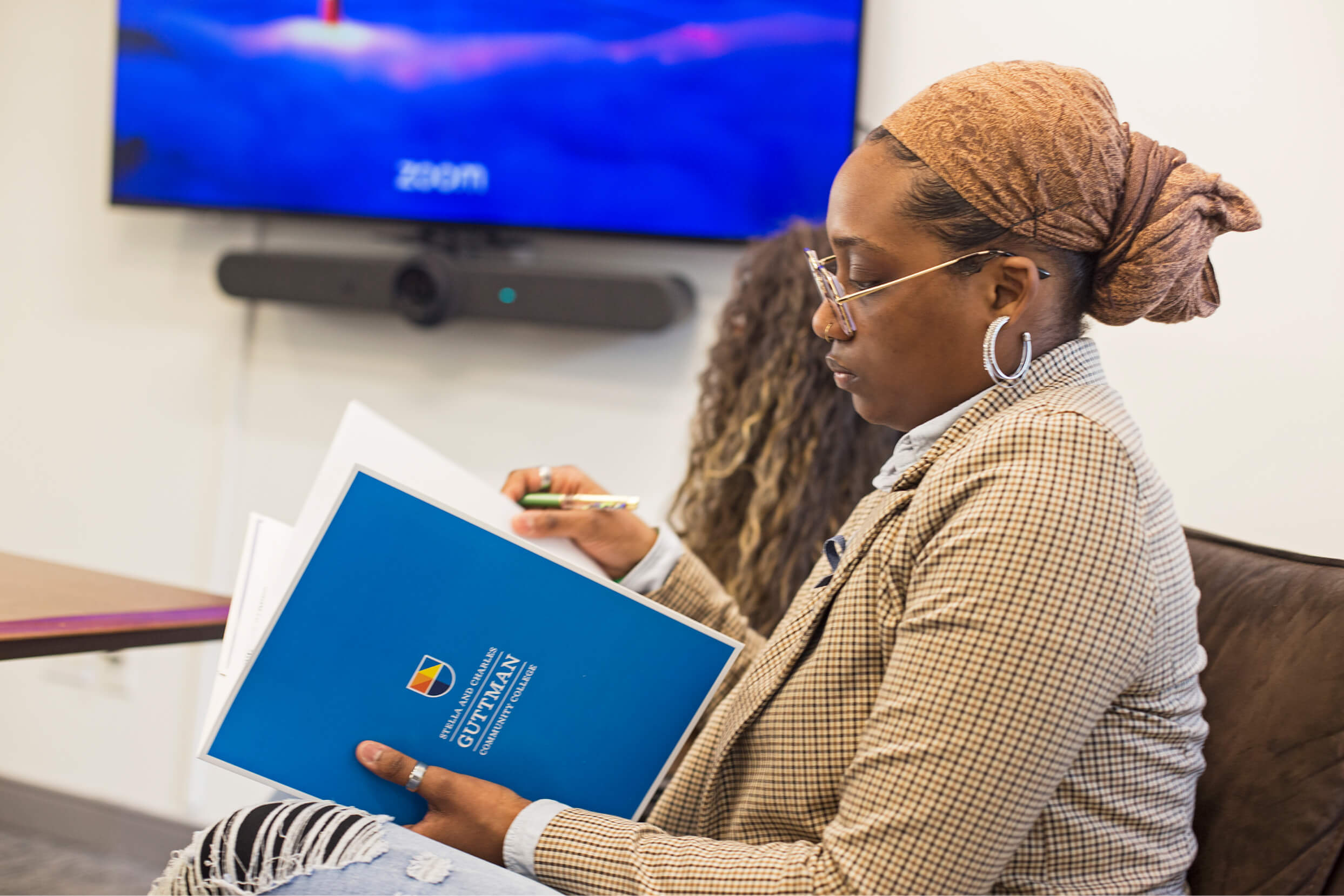In his first-year seminar class, Commencing Character, Professor Michael Lamb asks his students to consider how seven strategies for character development are exemplified in some of history’s most memorable commencement speeches. At the end of the semester, the students are asked to write their own addresses, revealing the virtues they have internalized, or at least found most salient. Lamb’s class is not about speechwriting. It is about learning how to become a better person, a concept that may seem naïve, unattainable, or even inappropriate in 2023 America, but it is one Lamb believes students and society urgently need.
“We’re facing a crisis of leadership in our country where we don’t have many leaders that are embodying the kind of virtues and values that we need to lead with courage, humility, justice and compassion,” said Lamb. “At the same time, institutions that once served as training grounds for moral formation are now playing less influential roles, leaving a gap for colleges and universities to shape the character of students, many of whom want guidance on how to live.”
Lamb argues that college is an important time to teach character since emerging adults are already experiencing existential angst and self-discovery. He and his colleague, Kenneth Townsend, run the Program for Leadership and Character at Wake Forest University, a multi-dimensional center of curricular and co-curricular activities, scholarship, training, and public engagement focused on creating leaders of good character in a range of disciplines and fields. While character education is not new (it was central to much American higher education in the past), Lamb, Townsend, and their team have revitalized a focus on character as they integrate it into leadership development, positing character as a catalyst for flourishing both within a person and for a community. With early funding from the Kern Family Foundation and a recent infusion of $30 million from the Lilly Endowment, Inc., the program is poised to grow into a national center on character education. To get there, it is focused on two key questions: Can character be taught? And if so, why aren’t we teaching it everywhere?
“We’re facing a crisis of leadership in our country where we don’t have many leaders that are embodying the kind of virtues and values that we need to lead with courage, humility, justice and compassion.”
Pro Humanitate
It is no coincidence that Wake Forest is now among the country’s leading institutions in character-based leadership. The founding motto of the liberal arts school in North Carolina is Pro Humanitate (“For Humanity”), connoting both a holistic approach to teaching and “a beyond the self” dimension. With a long tradition of study in this area, Wake Forest faculty like Christian B. Miller, Eranda Jayawickreme, William Fleeson, and R. Michael Furr are worldwide experts on character. In 2017, then President Nathan Hatch, a longtime advocate of this work, cemented the distinction by launching the Program for Leadership and Character and recruiting Lamb to run it.
Lamb grew up on a farm in Tennessee. Though his parents did not graduate from college, they taught him how to live with integrity. He did community service 10 hours a week in Memphis as part of his scholarship to college. He later became a Rhodes Scholar and went to Princeton University for his doctorate. “That experience of connecting deep exploration of how we ought to live with practical engagement in the community really helped me see the ways in which a liberal arts education could inform how I think and live,” he said.
As a postdoctoral fellow at Oxford, Lamb helped launch the Oxford Global Leadership Initiative within the Oxford Character Project, where he gained recognition as an expert on the subject with a distinctively pragmatic approach. He argues that leadership steered by virtues of character has enormous benefits, including building trust among citizens and employees, making institutions stronger, and improving results. He cites research showing that, despite the current tolerance for disinformation, people value leaders who can make ethical decisions and are trustworthy.
Like Lamb, Kenneth Townsend’s decision to teach character to the next generation of leaders is deeply personal. Townsend also rose from humble roots in the rural south and went on to receive dual degrees in law and divinity at Yale University. Townsend and Lamb met twenty years ago when Townsend was also a Rhodes Scholar, and the two became friends. “My commitment to my work at Wake Forest is very much rooted in what I learned from my own education—the sense that students need to have an opportunity to live, think, and act in holistic sorts of ways; where their lives and work can be integrated and they’re not forced to separate who they are from what they do,” he said.
Townsend oversees the program’s work with the university’s professional schools and programs—law, medicine, engineering, and divinity—where the absence of character in leadership can have enormous consequences. He views what they teach in the program as far beyond ethics-as-compliance. “For this to stick and for people not to just roll their eyes, we have to make the case for how having empathy, for example, will make law students better lawyers,” he said. “If this is viewed as just another box to check, it won’t be taken seriously, and it won’t have as great of an impact in students’ lives.”

Christopher Stawski, senior program director and senior fellow of the Kern Family Foundation, said the foundation had its eye on Wake Forest’s character work for some time, given its own mission “to build flourishing lives anchored in strong character.” After productive conversations with President Hatch, they arrived at supporting a new engineering program at the school that would explicitly integrate character into the curriculum. In 2021, with strong support from the current Wake Forest President Susan R. Wente, Kern invested $8.6 million in the Program for Leadership and Character that would expand this approach into the professional schools and pre-professional programs at Wake Forest, reflecting a philosophy already underway at the Kern National Network for Flourishing in Medicine.
“You want to embed character into the educational process early so people are considering this at the onset of their professional journeys,” said Stawski. “‘What kind of lawyer, or doctor, or engineer do I want to be?’ And they need to have that vision of themselves when they confront difficult decisions, whether it’s in medical ethics or artificial intelligence.”
Overall, Wake Forest’s Program for Leadership and Character is divided into three pillars that, taken together, create a prototype for how to teach, test, and scale character-based leadership. The student experience includes courses within both undergraduate and graduate schools, discussion groups focused on topics such as the “purpose of college” and the “role of friendship,” and creative programming that explores leadership and character through art, athletics, and religious life. Rounding this out are the Leadership and Character Scholars, an annual cohort of students from diverse racial and socioeconomic backgrounds who have exhibited leadership and character in high school and receive merit and need-based scholarships to participate in the program’s activities throughout their four years at Wake Forest.
The second pillar is the curriculum development work that is done in a series of workshops and trainings of varying intensity with faculty. This allows interested faculty in every school or department within the university to incorporate character into what they are teaching, in some instances redesigning courses, be they in communication or computer science. In many ways, this is the most transformative element of the program in that it puts character-based leadership in any domain, grounding it into the pedagogy.
The third component involves a research and assessment team tasked with evaluating the strategies that are used to promote character growth in the programming and courses. This involves continuously collecting data on student outcomes.
Lamb’s Commencing Character course informs the faculty training and is where the foundational learning takes place for many undergraduates. The course uses seven strategies that are consistent with an Aristotelian approach to character development and supported by research in education, philosophy, and psychology. Each strategy gets unpacked with relatable language and comes with practical exercises that students apply to their own lives with the goal of attaining virtues such as purpose, justice, courage, and gratitude.
“You want to embed character into the educational process early so people are considering this at the onset of their professional journeys. ‘What kind of lawyer, or doctor, or engineer do I want to be?’”
The course is proactive and self-reflective. The first strategy, “habituation through practice,” suggests you can’t just read about virtues, you must learn them by performing virtuous actions. “Engagement with virtuous exemplars” involves examining role models who have exhibited good judgment in challenging situations—the proverbial “What would Jesus/my mother/Ted Lasso do?” Another, “reflection on personal experience,” asks students how and why they act in a certain way under certain circumstances. With “increasing awareness of influence and biases,” students are shown examples of how to understand their own assumptions and develop curiosity about differences. One of the weightier ones is “moral reminders”—psychological alerts that keep us from doing the wrong thing by recalling a commitment to important values or norms.
The course is open to anyone but is a requirement for the Leadership and Character Scholars, the undergraduates who have been given the challenge and the privilege of becoming people of good character. Here is also where the importance of embedding character development into leadership is personified. “These students are the ones that, by and large, are going to have some measure of power and agency in the world,” said Ann Phelps, a trained jazz musician with a degree in theology and the arts from Yale, who runs the undergraduate program with Lamb and oversees the Scholars. “We want them to understand that their choices will impact the lives of others and, at the very least, not to ignore the hard questions.”
Leaders in Training
While making a case for why an individual’s character growth benefits others, Phelps is witness to how this work can transform a person’s own life. Her involvement with the Scholars includes everything from recruiting and onboarding students, to running programs and discussion groups, to supporting them personally when the growth gets hard. She is perhaps best positioned to refute the notion that character is hardwired or only for those with proper upbringings. “Anyone has the capacity to develop strong character,” she said. “These students arrive at college with limitations and opportunities for growth (like we all have), often covered by talent, work ethic, intelligence, or pure luck. They could easily thrive in life without trying to become kinder, more courageous, or more just, but in this space, they work on developing virtues anyway.” On a Zoom call in late spring, she asked two of her students to discuss their experiences in the Leadership and Character Scholars program.
Sofia Ramirez Pedroza is in her junior year and is excited she still has a quarter of the program left. She said it has had a profound influence on her, both in terms of how she sees herself and what she would like to do with her life. “Whether it’s a big goal or a small goal, I just see the world differently now,” she said.
Sofia had a full ride to Wake Forest and didn’t think too much about the impact of what she had just been granted, but the intentionality of the program soon became evident. “This was not a loose kind of thing,” she said. “I came to understand that this was a place where they really cared about the cultivation of good people. Ann and Dr. Lamb and the rest of the people involved were very much invested in who we were becoming.”
At first, she didn’t know what that would look like for her. Sofia is Hispanic and credits her loving family with a confidence that clearly shows in her outgoing personality. But despite her easy nature, she says she developed a tough exterior to shield her from a lifetime of feeling undeserving—the “quota girl,” she said, who wouldn’t have made it otherwise. “I was very much a pessimistic person so I didn’t even know I had the capacity of understanding that I really could grow into the person I want to become.”
Sofia said the virtues she most wanted to cultivate with the seven strategies were gratitude and hope, which she wrote about in her end-of-semester commencement speech and said she owes to the people in the program. A subtle but important clue to her character growth is revealed when she discusses her career, which she now views as not just about herself.
“I’ve always wanted to do something in sports, but as a Hispanic female I didn’t really think there was a space for me,” she said. “Then I thought, why not? I decided to go for it, not just for me, but for the sea of people that come behind me that didn’t get granted these opportunities.”
Rachel Edwards just graduated and was among the program’s first cohort in 2019. When she first received the scholarship into the program, she said she was intrigued by the concept but didn’t really know what to expect. “Maybe I’d become a leader of a club or something, but I had no idea the extent to which I, Rachel Edwards, would change as a person.”
When Rachel came to Wake Forest, she was a pre-med major determined to fulfill her and her family’s dream of becoming a doctor. Shortly after she arrived, she intervened in a sexual assault on behalf of her friend and was left “wrecked by it.” Her mental health suffered, and she went to Phelps for advice, thinking she might transfer.
“At the same time, we were reading Aristotle’s book, Nicomachean Ethics, and I was really curious about what this old white man had to say about justice,” she said. “It ended up being something I could hold onto and do something with instead of just going away, so I began to form a conception of justice as a virtue.”

Rachel also began working at the school’s Title IX office where the staff was scrambling to adapt to then Education Secretary Betsy Devos’ new regulations on sexual assault. She dove into the work and remained involved throughout her four years at Wake Forest. “This is what justice for my friend looked like for me,” she said. She eventually found the courage to tell her parents she wasn’t going to become a doctor. In the fall of 2023, she is headed to law school.
When asked about her wellbeing, Rachel said, “I think when you develop your character, you’re simultaneously developing your wellbeing – you’re developing skills to approach the world. In every situation that took me to the lowest of lows, it was the program, and the people in it, that brought me back. And it wasn’t a superficial thing like, ‘I get to hold Ann’s hand.’ It was what Ann was teaching me. It was the content.”
The Case for Character
While Rachel and Sofia’s stories anecdotally demonstrate what the program is capable of, Lamb and Townsend have more tangible evidence to show the academic community. Numerous papers convey the results of the assessments they have done that show that students in Lamb’s course grew in seven targeted virtues compared to control groups; strengthened a sense of purpose including a “beyond the self” purpose that focused on flourishing within a community; and developed a growth mindset—a belief that self-improvement is possible if they try. The faculty training workshops have proven to increase professors’ understanding of character education as well as their confidence in incorporating these ideas into their classes.
When asked if all students should receive character and leadership training, Sofia said, “Of course. I mean, why wouldn’t you want to be a better person?”
Accompanying these materials are infographics showing that between all three pillars, and a fourth involving external-facing conferences and seminars, the program can count over 25,000 individual engagements in the last three years alone, including hundreds with faculty and staff at other colleges and universities. This is an important metric as the program uses the new Lilly Endowment, Inc. grant money to make character education contagious throughout the country.
Though not stated, these documents also serve to fend off the critics of this work, the “eye rollers” Townsend refers to who believe it’s “soft stuff,” or others who see it as preachy or patronizing. Lamb says the urgency for character-based education may be the strongest defense in a world where leadership is confused with celebrity and young people are hungry for something to believe in.
When asked if all students should receive character and leadership training, Sofia said, “Of course. I mean, why wouldn’t you want to be a better person?”












